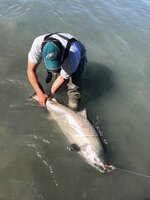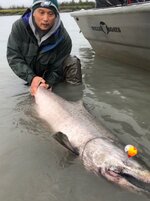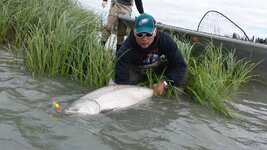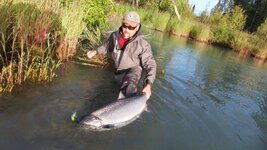Apologies in advance for the long post.
If you want to fast forward to the links at the end, here is the short version, I am hoping to drum up some public comments advocating for stronger conservation efforts for the imperiled king salmon runs on the world-famous Kenai River in Alaska. The Alaska Department of Fish and Game is holding public meetings in late Feb and taking comments on proposed management actions through Feb 8, 2024.
Here is the long version.
Kenai River Kings – An Endangered Species Needs Our Help
The Kenai River is world famous for both the quantity and quality of its king salmon. Home to the current world-record sport-caught king (97lbs 4 ounces) and 6 of the other top 10 king salmon ever landed, the Kenai, leading up to 2009, averaged 53,000 king salmon returning to the river each year as part of the “late run.” In 2004, 91,000 kings swam into the Kenai River.
Fast forward to the current day. Kenai kings are in trouble with runs the last three years averaging 11.5k-14k fish, the lowest returns on record. Not only are the run sizes as a whole greatly diminished, the runs now consist of fish that are both younger and smaller than has historically been the case. The 7-year-old giants are all but extinct. I have had the chance to lay hands on a few of these magnificent beasts over the years and I can honestly say it is a life changing experience. Sadly, this same opportunity for future anglers may never exist.
Much more could be said on both the history and current state of the Kenai kings, but I don’t want to bury the lede here. We are at a very critical juncture for management of the Kenai River kings, one that will play a part in whether or not these special fish continue to exist.
In 2023 the Alaska Department of Fish and Game (ADFG) designated the Kenai River late-run kings a “stock of management concern.” This designation comes with the requirement to put together a management/action plan to help address the causes of decline and, hopefully, help rebuild the run. That recently published plan is below.
The ADFG Board of Fish (BOF) is holding their annual Upper Cook Inlet fisheries meeting February 23-March 6, 2024. The primary purpose of this meeting is to discuss and evaluate proposals for changes in current regulations and management practices, to include the Kenai River and its late-run king salmon.
Another important bit of background. Commercial fishing and personal use set-net fishing for Kenai River sockeye salmon, which overlap with the king salmon runs on the Kenai, and sport fishing for kings in the river are married in the Kenai River management plan. That is, when one user group is restricted from fishing, so is the other. The nets in the inlet and on the beach kill a very significant number of king salmon when they are allowed to fish. As such, when the numbers of kings in the river are projected to be below the “optimal escapement goal” or “OEG,” both the sport fisherman and nets are restricted in a stepped-down manner and if things look bad enough, fishing in the river is shut down entirely and the nets aren’t allowed to fish in the most critical areas.
The way ADFG has typically managed this fishery is that they start the season with a very liberal approach, typically allowing both in-river harvest of kings by the sport fisherman and the sockeye nets to fish in the inlet and off the beach. The way this has played out the last few years is that by the time they realize the king run is tanking and start implementing restrictions, it is already too late, and a bunch of kings have already died while the run falls well short of the low end of the OEG.
A much better approach would be to start the fishing and netting very conservatively, and then as (if?) the king run materializes in acceptable numbers, allow additional harvest, fishing, and netting opportunities.
Commercial fishing and personal use set-netting are huge industries in Alaska and are both sewn into the fabric of the state and many that live here. Many people’s livelihoods and ways of life depend on these practices, and so when ADFG shuts these fisheries down, it negatively impacts a large group of people. These user groups also wield a tremendous amount of political power and influence. As such, ADFG is under a massive amount of pressure to keep the commercial and set-net sockeye fisheries open even in times where it is painfully obvious that the negative impacts to the kings will be unacceptable.
Back to the BOF meeting. At the meeting in February, the BOF will consider a long list of proposed changes to the current regulations governing Kenai kings, among many others.
The current OEG set by ADFG for the late-run Kenai kings is 15,000-30,000 fish. There are currently eight proposals that are lobbying for the OEG TO BE REDUCED, no doubt to allow additional time for the nets to fish for sockeye. No matter how you look at the data, there is no justifiable scientific support for such a decision that if it were to be made, would be made for one reason and one reason only, to support commercial interests to the continued detriment of king salmon. Most that know the fishery well would argue that the low end of the OEG, 15,000 fish, is already way too low to support a healthy run, self-sustaining run and our target should be the upper end of the goal at 30,000 fish, at a minimum.
Proposal number 83, authored by my good friend, mentor, and a man that knows the Kenai kings and fisheries management better than most, Francis Estalilla, proposes that ADFG implement a more conservative approach to the late-run king and sockeye fishery as described above. In short, when the pre-season forecast is at or below the OEG, the fisheries would start in a conservative manner and then be liberalized as (if) acceptable numbers of fish show up. It’s more complicated than that, but that is the gist. The “kill them first and hope more show up” strategy is not working, and the kings are running out of time.
So, here is my ask for anyone that cares about the Kenai River kings and wants to help save them from what seems like inevitable extinction. Public comments are due by Feb 8, 2024.
1. Go to the ADFG Board of Fish web site and submit comments for the upcoming meeting. (https://www.adfg.alaska.gov/index.c...meetinginfo&date=02-23-2024&meeting=anchorage)
2. In these comments, tell ADFG that LOWERING the current OEG for late-run king salmon in order to allow/justify commercial fishing and netting in the inlet is entirely unacceptable and should not be considered.
3. Voice support for proposal 83 that proposes a conservative start to the fisheries and then loosening restrictions when/if the kings show up in acceptable numbers.
For those interested in additional background and more education on these subjects, I would highly recommend the following articles in addition to other resources put out by ADFG linked below.
For those that made it this far, and especially those that take a few minutes to provide a comment to help save the kings, thank you very much.
If you want to fast forward to the links at the end, here is the short version, I am hoping to drum up some public comments advocating for stronger conservation efforts for the imperiled king salmon runs on the world-famous Kenai River in Alaska. The Alaska Department of Fish and Game is holding public meetings in late Feb and taking comments on proposed management actions through Feb 8, 2024.
Here is the long version.
Kenai River Kings – An Endangered Species Needs Our Help
The Kenai River is world famous for both the quantity and quality of its king salmon. Home to the current world-record sport-caught king (97lbs 4 ounces) and 6 of the other top 10 king salmon ever landed, the Kenai, leading up to 2009, averaged 53,000 king salmon returning to the river each year as part of the “late run.” In 2004, 91,000 kings swam into the Kenai River.
Fast forward to the current day. Kenai kings are in trouble with runs the last three years averaging 11.5k-14k fish, the lowest returns on record. Not only are the run sizes as a whole greatly diminished, the runs now consist of fish that are both younger and smaller than has historically been the case. The 7-year-old giants are all but extinct. I have had the chance to lay hands on a few of these magnificent beasts over the years and I can honestly say it is a life changing experience. Sadly, this same opportunity for future anglers may never exist.
Much more could be said on both the history and current state of the Kenai kings, but I don’t want to bury the lede here. We are at a very critical juncture for management of the Kenai River kings, one that will play a part in whether or not these special fish continue to exist.
In 2023 the Alaska Department of Fish and Game (ADFG) designated the Kenai River late-run kings a “stock of management concern.” This designation comes with the requirement to put together a management/action plan to help address the causes of decline and, hopefully, help rebuild the run. That recently published plan is below.
The ADFG Board of Fish (BOF) is holding their annual Upper Cook Inlet fisheries meeting February 23-March 6, 2024. The primary purpose of this meeting is to discuss and evaluate proposals for changes in current regulations and management practices, to include the Kenai River and its late-run king salmon.
Another important bit of background. Commercial fishing and personal use set-net fishing for Kenai River sockeye salmon, which overlap with the king salmon runs on the Kenai, and sport fishing for kings in the river are married in the Kenai River management plan. That is, when one user group is restricted from fishing, so is the other. The nets in the inlet and on the beach kill a very significant number of king salmon when they are allowed to fish. As such, when the numbers of kings in the river are projected to be below the “optimal escapement goal” or “OEG,” both the sport fisherman and nets are restricted in a stepped-down manner and if things look bad enough, fishing in the river is shut down entirely and the nets aren’t allowed to fish in the most critical areas.
The way ADFG has typically managed this fishery is that they start the season with a very liberal approach, typically allowing both in-river harvest of kings by the sport fisherman and the sockeye nets to fish in the inlet and off the beach. The way this has played out the last few years is that by the time they realize the king run is tanking and start implementing restrictions, it is already too late, and a bunch of kings have already died while the run falls well short of the low end of the OEG.
A much better approach would be to start the fishing and netting very conservatively, and then as (if?) the king run materializes in acceptable numbers, allow additional harvest, fishing, and netting opportunities.
Commercial fishing and personal use set-netting are huge industries in Alaska and are both sewn into the fabric of the state and many that live here. Many people’s livelihoods and ways of life depend on these practices, and so when ADFG shuts these fisheries down, it negatively impacts a large group of people. These user groups also wield a tremendous amount of political power and influence. As such, ADFG is under a massive amount of pressure to keep the commercial and set-net sockeye fisheries open even in times where it is painfully obvious that the negative impacts to the kings will be unacceptable.
Back to the BOF meeting. At the meeting in February, the BOF will consider a long list of proposed changes to the current regulations governing Kenai kings, among many others.
The current OEG set by ADFG for the late-run Kenai kings is 15,000-30,000 fish. There are currently eight proposals that are lobbying for the OEG TO BE REDUCED, no doubt to allow additional time for the nets to fish for sockeye. No matter how you look at the data, there is no justifiable scientific support for such a decision that if it were to be made, would be made for one reason and one reason only, to support commercial interests to the continued detriment of king salmon. Most that know the fishery well would argue that the low end of the OEG, 15,000 fish, is already way too low to support a healthy run, self-sustaining run and our target should be the upper end of the goal at 30,000 fish, at a minimum.
Proposal number 83, authored by my good friend, mentor, and a man that knows the Kenai kings and fisheries management better than most, Francis Estalilla, proposes that ADFG implement a more conservative approach to the late-run king and sockeye fishery as described above. In short, when the pre-season forecast is at or below the OEG, the fisheries would start in a conservative manner and then be liberalized as (if) acceptable numbers of fish show up. It’s more complicated than that, but that is the gist. The “kill them first and hope more show up” strategy is not working, and the kings are running out of time.
So, here is my ask for anyone that cares about the Kenai River kings and wants to help save them from what seems like inevitable extinction. Public comments are due by Feb 8, 2024.
1. Go to the ADFG Board of Fish web site and submit comments for the upcoming meeting. (https://www.adfg.alaska.gov/index.c...meetinginfo&date=02-23-2024&meeting=anchorage)
2. In these comments, tell ADFG that LOWERING the current OEG for late-run king salmon in order to allow/justify commercial fishing and netting in the inlet is entirely unacceptable and should not be considered.
3. Voice support for proposal 83 that proposes a conservative start to the fisheries and then loosening restrictions when/if the kings show up in acceptable numbers.
For those interested in additional background and more education on these subjects, I would highly recommend the following articles in addition to other resources put out by ADFG linked below.
- History and background on the Kenai late-run kings and recent management actions. https://www.fishalaskamagazine.com/kenai-river-king-counts/
- The Quest for a Better Way – Future Kenai Late-Run King Management, Francis Estalilla (PDF linked to post)
- ADFG Kenai River Late-Run King Salmon Stock Status and Action Plan (https://www.adfg.alaska.gov/static/...fisheriesboard/pdfs/2023-2024/uci/SP23-11.pdf)
- ADFG BOF Meeting page including current proposals for regulation changes (https://www.adfg.alaska.gov/index.c...meetinginfo&date=02-23-2024&meeting=anchorage)
For those that made it this far, and especially those that take a few minutes to provide a comment to help save the kings, thank you very much.
Attachments
Last edited:





